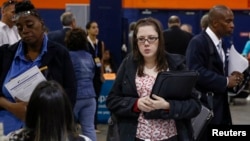The U.S. workforce is growing and evolving as some kinds of jobs disappear and others become more widespread.
A recent study by the Department of Labor's Bureau of Labor Statistics said the number of manufacturing jobs would continue its long-term decline between now and 2024. Other experts say some U.S. manufacturing jobs have gone to nations with lower wage costs. Far more jobs have vanished because growing efficiency from automation and robots means fewer people are needed in the manufacturing process.
The bureau projected that manufacturing employment would decline at an annual rate of 0.7 percent per year over the next few years. While that troubles workers, it would be a slower rate of decline than the 1.6 percent annual decline seen in recent years.
There was a similarly mixed picture in the construction sector in the bureau's report. Builders were projected to add nearly 800,000 U.S. jobs by 2024, but the job gains will not be enough to bring employment back to the peak level of 2006, right before severe problems in the housing sector helped spark a recession.
The BLS experts also projected that the majority of new jobs created in the coming years would be in the services sector, particularly health care and social assistance.
Health care and technical occupations were predicted to be the two fastest-growing occupation groups in the near future. Together, they could have a gain of 2.3 million jobs over the next eight years, or about one out of four new jobs, the BLS said.
The changes in the job market come as the overall workforce is growing at about 0.5 percent a year and is expected to expand to nearly 164 million people by 2024, the BLS said.
A snapshot of the U.S. job market will be available Friday morning when government experts publish June's unemployment rate. A survey by the Bloomberg financial news service shows economists expect the unemployment rate to rise slightly, hitting 4.8 percent. They also predict a net gain of 180,000 jobs across the economy.
The job gains are a big change from the prior month, when just 38,000 jobs were gained, according to a separate BLS report. Part of the problem was a strike by communications workers that temporarily idled 35,000 people. The strike has since been settled.
Last month's disappointing job data and uncertainty growing out of Britain's historic vote to leave the European Union worried top U.S. central bank officials, who are putting off expected increases in a key interest rate.
That information came from notes, released Wednesday, from mid-June's meeting of the Federal Reserve committee that sets interest rates and other policies. The Fed had cut the rates nearly to zero during the recession to boost economic growth. Economists say interest rates will have to go back up closer to their historic averages — eventually — or the economy could be overstimulated, sparking damaging inflation.






